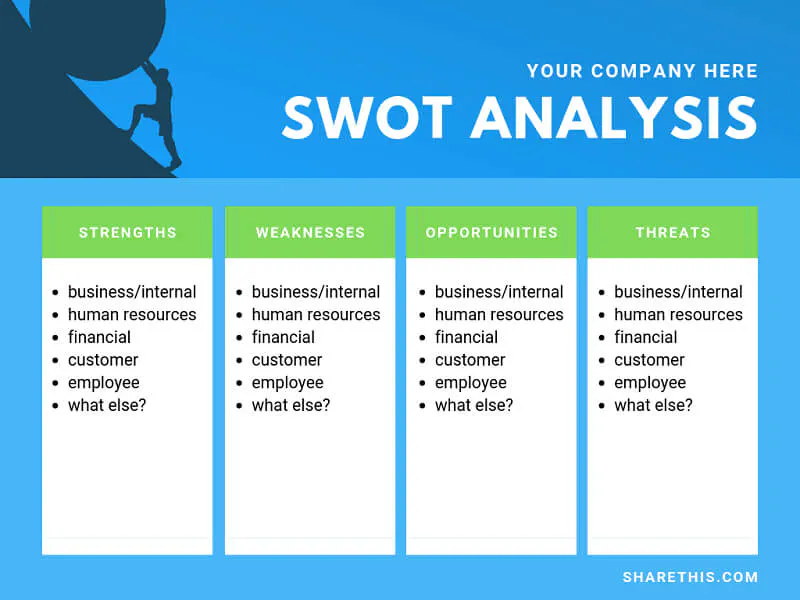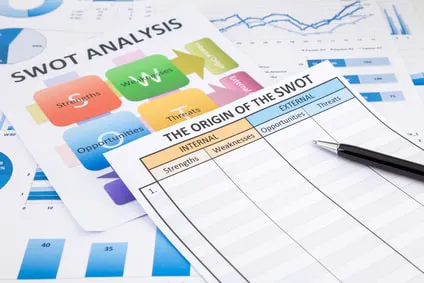If you’re in marketing, you’re probably familiar (too familiar?) with the SWOT analysis – with identifying your company or brand’s strengths, weaknesses, opportunities, and threats. And, we know – there’s already a lot written about SWOT (entire books, in fact), so we won’t try to reinvent the wheel in one post. What we will do, though, is simplify the SWOT process. How can you make it work for you?
Definition of a SWOT analysis
The SWOT analysis is both a simple and effective tool to help evaluate, critique, and improve your brand strategy, whether you’re a one-person operation, a startup, a growing brand, or a big company. If you’re creating a social media marketing proposal for a new client, it’s a good idea to conduct a SWOT analysis. Even if you’re considering branching out to a new market or to new marketing channels (maybe you’re considering launching an influencer marketing campaign, for example), a SWOT analysis is in order. A SWOT analysis is useful in countless scenarios. In other words, it’s a powerful tool for anyone who does business.
At its most basic, the SWOT analysis is an acronym of its parts: strengths, weaknesses, opportunities, and threats. Dig a little deeper, and you’ll discover that the SWOT analysis covers both internal factors (your strengths and weaknesses), as well as external influences (opportunities in threats), to paint a full picture of your specific market: In other words, the important factors over which you have control, and the uncontrollable influences to which you can (and should) respond.
Still sound cryptic? Then, let’s get a little more detailed.
 The SWOT analysis asks, what are your strengths, weaknesses, opportunities, and threats?
The SWOT analysis asks, what are your strengths, weaknesses, opportunities, and threats?
SWOT analysis: analyze your strengths
The keystone of any effective SWOT analysis is in identifying your strengths: What are you great at? It’s a big (and broad) question, and one that takes a bit of creative thinking. Don’t be too literal. Do consider the full gamut of your strengths:
- Business/internal strengths: What do you do, better than anyone else?
- Human resource strengths: What are your strongest assets – at what knowledge, skills, education, and experience does your team excel?
- Financial strengths: We’re talking about more than your cash assets and accounts receivable; what are your current most reliable sources for financial growth?
- Customer strengths: What are the best sources of customer/client growth (ex. referrals)? Why do your customers/clients choose you over your competitors? In other words, what’s your competitive advantage? If you conduct a social media audit and it reveals particularly strong engagement on a particular channel or high conversions for a certain offer, for instance, these insights offer clues into your customer strengths.
- Employee strengths: Your employees are a huge asset to your company, so where do you excel in this regard: Your pay/compensation structure? Your workplace culture? Your benefits?
Note that your strengths are internal factors – items over which you have control. You can improve your current strengths and add to them over time; the power to progress is always within reach.
SWOT analysis: identify your weaknesses
With the broadest stroke of the brush, “weaknesses” are defined as any factors that detract from your strength – as anything that stops you from performing at optimum levels. In other words, what kills your successful vibes?
- Business/internal weaknesses: What do you know you need to improve? Where do your competitors have you beat? What do you need to improve, in order to sharpen your competitive edge? Perhaps you need to drive more traffic to your company’s blog or boost engagement on Facebook or Instagram.
- Human resource weaknesses: Are there knowledge/skill gaps within your team? Do they need better training in any aspect of your business or customer service?
- Financial weaknesses: Are there any tangible assets you need? What are your greatest barriers to financial success? (Examples: You’re in the vacation industry and most of your clients are one-time, not repeat guests. Or, you’re in the midst of a budget crunch – meaning you need to come up with effective, low-cost marketing ideas.)
- Customer weaknesses: This isn’t about the weaknesses your customers face, but rather your weaknesses, from the viewpoint of your customers: What are your most common customer/client complaints? Where do you need to improve, in order to boost customer satisfaction? (Not sure what your customer strengths and weaknesses are? Social listening can offer valuable insights.)
- Employee weaknesses: Do you have high turnover? Low satisfaction? Lots of employee complaints to HR? Could you treat your team better?
Like your business strengths, your weaknesses are also considered an internal factor: Theoretically, you have control over your weaknesses. In other words, you may be able to improve them.
SWOT analysis: suss out your opportunities 
As a direct byproduct of identifying weaknesses, you’ll hone in on opportunities – on the external factors over which you have some, but not full control (because they are co-dependent on other factors), but that do inform your current and future success. A good way to think of this is, “Where can we identify future possibilities for success?”
- Business/internal opportunities: Considering the internal weaknesses you identified, what opportunities do you see to improve? This could be new lines of credit, sponsorships, or even cutting a product that isn’t performing well. Are there any new regulations, services, or product closures looming, that could create growth opportunities for your business? What about social media marketing trends you could be leveraging?
- Human resource opportunities: Are there knowledge/skill gaps within your team? Do they need better training in any aspect of your business or customer service?
- Financial opportunities: What is the single greatest opportunity to improve your company finances: Boost repeat customers/customer retention? Expand into a new area or region? Launch a new product?
- Customer opportunities: What could you do tomorrow, that would complement your customer successes (and alleviate your weaknesses) today? Could you sell complementary products or services? Could you cross-sell? Could you improve your online shopping cart? Where is your market trending?
- Employee opportunities: This is a tough one, since your employees are typically an internal (and thus, controllable) factor. However, think of it like this: What opportunities exist to create happier, more satisfied employees? Can you identify any training opportunities that will put your team ahead of a projection/curve only you can see (for now)?
SWOT analysis: recognize your threats
Now that you understand your opportunities for growth, it’s time to get real – scary real. What are the biggest threats to your future success? What external factors could harm you? Because, yes – we’re talking external factors over which you have no control. But, an ounce of prevention is worth a pound of cure: identify your threats, and you need only an ounce of prevention to counteract them.
- Business/internal threats: Internal threats are generally internal (within your control), but still, consider – what current aspects of your business could harm your own business, down the road?
- Human resource threats: Are you behind on training? Are there gaps in your team’s knowledge? Does your competitor’s team consistently one-up yours? Do they know something you don’t?
- Financial threats: What external threats, both current and possible, could seriously impact your financial health? We’re talking everything from changing laws/regulations, to low-cost competitor launches on the horizon.
- Customer threats: Could someone else make your customers happier than they are with you? Do your competitors offer greater perks? What could lure your customers away?
- Employee threats: What real or perceived threats weigh on your employee satisfaction or happiness? What do your competitors do, that you don’t, that could cause your team to jump ship and work for the other guy?
As you can see, a SWOT analysis requires plenty of free and creative thinking: looking at the big picture, staring into the future, and really getting honest with yourself. So, while it may be a simple exercise, it’s also not something you can complete in a 5-minute brainstorming session.
Give yourself time. Run through the SWOT analysis once, then come back again in a few days or a week. Confer with members of your team. And, as we said, be honest. The only company you hurt, by not owning the whole picture, is your own. Good luck and may the SWOT be with you!
Now that you’ve identified your strengths, weaknesses, opportunities, and threats, it’s time to put concrete plans into action to leverage those opportunities. It doesn’t have to be complicated; simple strategies like installing a LinkedIn follow button can help you grow your audience. It takes just minutes to install, so you can start reaching new prospects – and making progress towards your goals – right away.




